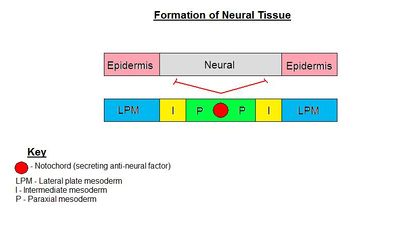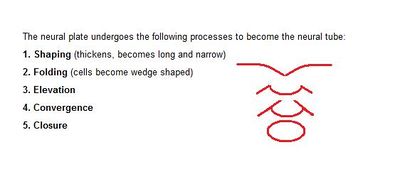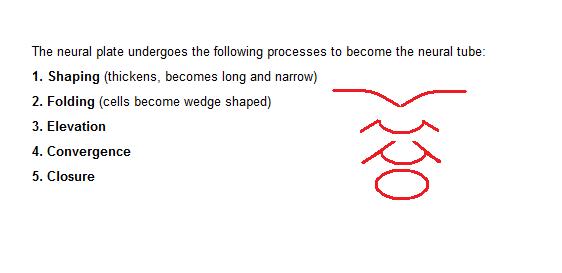Difference between revisions of "CNS Development - Anatomy & Physiology"
| Line 11: | Line 11: | ||
<br /> | <br /> | ||
<br /> | <br /> | ||
| − | Formation of the neuroectoderm occurs as a result of the folding of the neural plate due to the presence of the Lateral Plate Mesoderm (LPM) factor. | + | Formation of the neuroectoderm occurs as a result of the folding of the neural plate due to the presence of the Lateral Plate Mesoderm (LPM) factor. The edges of the neural plate begin to fold upwards and inwards, eventually leading to the formation of a neural crest and tube. LPM also initiates the formation of epidermis from ectoderm and therefore areas of ectoderm dorsal to the neural tube differentiate into epidermis. |
| − | [[Image:WIKIVETformationofneuraltissue.jpg|thumb| | + | [[Image:WIKIVETformationofneuraltissue.jpg|thumb|left|400px|Formation of Neural Tissue - © Sophie Stenner]] |
| + | [[Image:WIKIVETneuraltubeformation.jpg|thumb|right|400px|Neural Tube Formation - © Sophie Stenner]] | ||
<br /> | <br /> | ||
| − | |||
<br /> | <br /> | ||
| − | |||
| − | |||
| − | |||
[[Image:WIKIVETneuraltubeformation.jpg]] | [[Image:WIKIVETneuraltubeformation.jpg]] | ||
[[Image:WIKIVETbraindifferentiation.jpg|thumb|right|150px|Brain Differentiation - © Sophie Stenner]] | [[Image:WIKIVETbraindifferentiation.jpg|thumb|right|150px|Brain Differentiation - © Sophie Stenner]] | ||
Revision as of 13:39, 4 August 2011
Introduction
Development of the Central Nervous System (CNS) includes development of the brain, spinal cord, optic and auditory systems, as well as surrounding supporting cells including ependymal cells, astrocytes, oligodendrocytes and microglia. Information within this page will exclude development of the Peripheral Nervous System (PNS) which includes nerve and ganglia formation. For further information on PNS development, please see the PNS development page.
For the appropriate development of the CNS a number of important basic requirements must be achieved. For example, the appropriate haemopoeitic cells must differentiate into specific cells (either neurons or glia) and any axons must extend to appropriate positions in order to form synapses. Development of the CNS is a complex process and complete coordination is required to facilitate the correct procedure of cell differentiation and the establishment of the correct intracellular connections. A range of neurotrophic factors regulate these interactions including FGF, nerve growth factor, laminin, brain derived neurotrophic factor and neurotrophin 3.
Developmental Origins
The embryological origin of the CNS is from the neural ectoderm which is a ridge of tissue in the centre of the early embryo once the basic blastula has undergone a degree of differentiation. The neural ectoderm is formed via the thickening of the ectoderm and it's interaction with underlying basic neural tissues including the notochord. This interaction results in the formation of the neural plate, termed the neuroectoderm. Below is a diagram of the completed initial stages of development to provide an indication of the anatomy of the development process.
Formation of the neuroectoderm occurs as a result of the folding of the neural plate due to the presence of the Lateral Plate Mesoderm (LPM) factor. The edges of the neural plate begin to fold upwards and inwards, eventually leading to the formation of a neural crest and tube. LPM also initiates the formation of epidermis from ectoderm and therefore areas of ectoderm dorsal to the neural tube differentiate into epidermis.
- Differentiation of the neural tube at the anterior then forms the brain.
- The diagram on the right shows how the brain transforms during development.
Origins of Functional Types of Neurone
| Nerve | Origin |
|---|---|
| Sensory - Afferent | Neural crest |
| Motor - Efferent | Basal plate of neural tube |
| Association - Interneurones | Alar plate of neural tube |
| This article is still under construction. |







